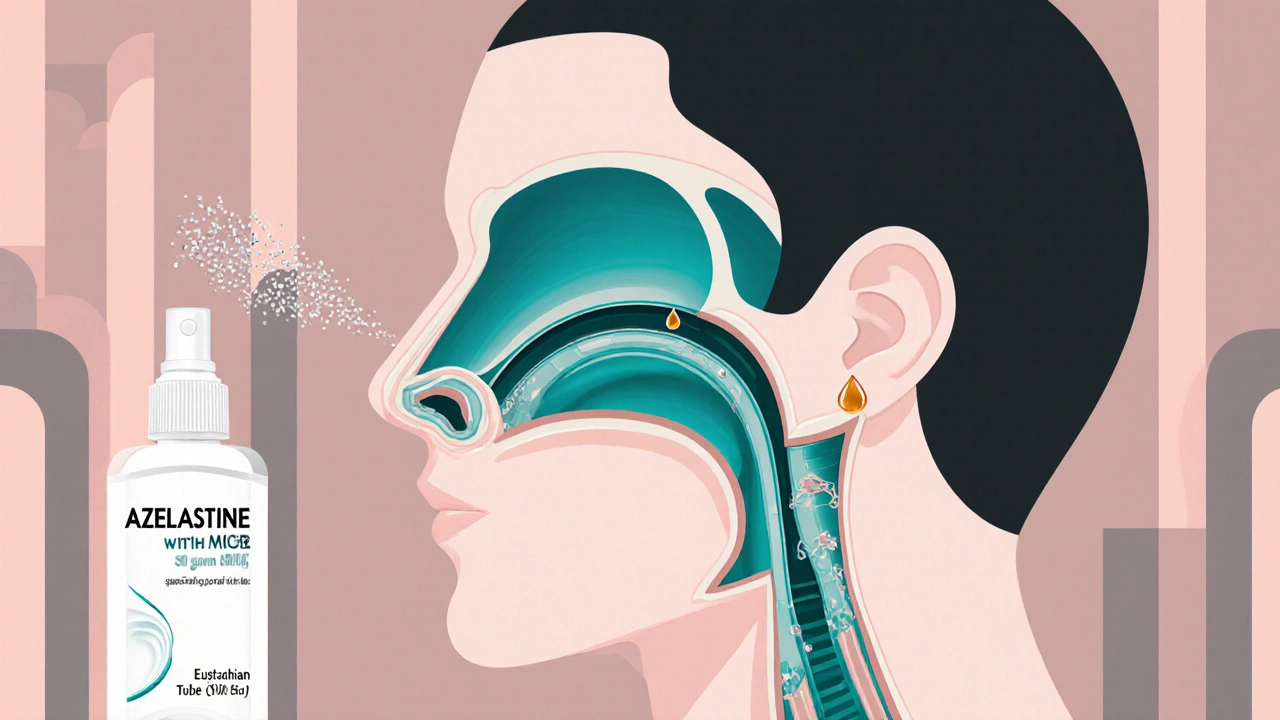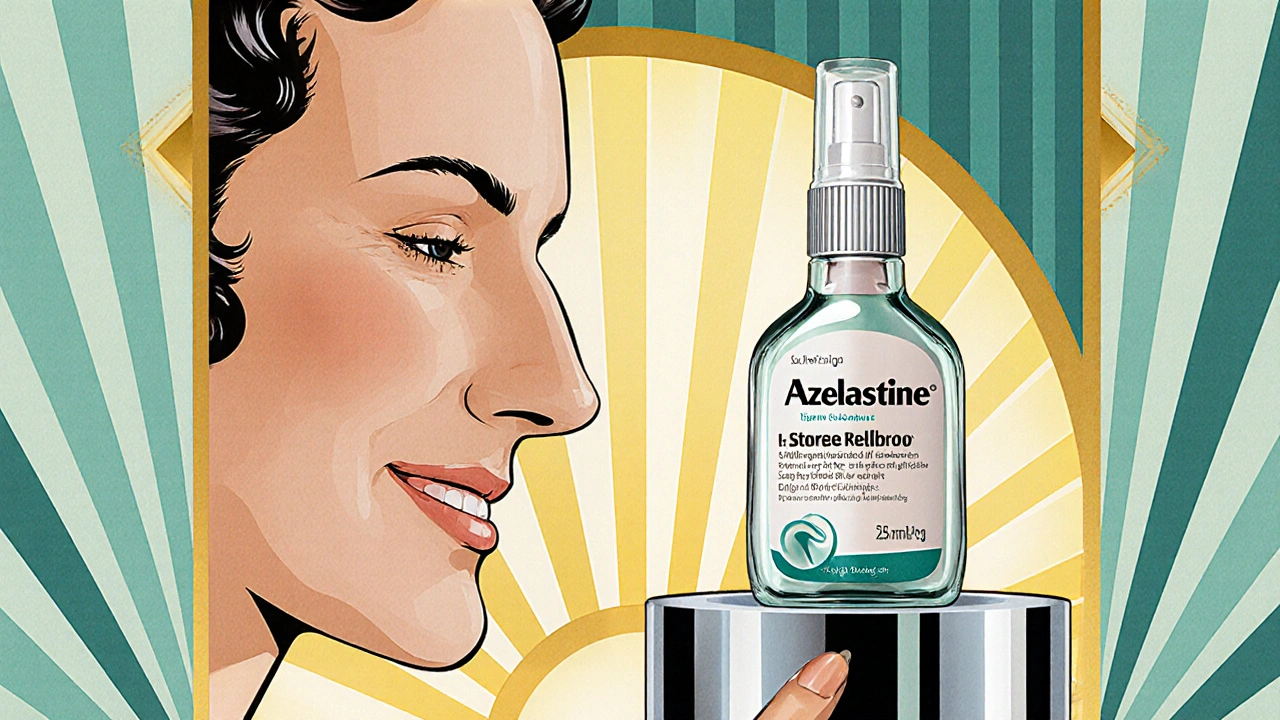Ear Symptom Checker
Check Your Symptoms
This tool helps you understand if your ear symptoms might be related to Azelastine use or other factors. It's not a medical diagnosis.
Results and Guidance
This tool is informational only. Always consult with a healthcare professional for medical advice.
When people use Azelastine is a second‑generation antihistamine delivered as a nasal spray to treat allergic rhinitis, they often wonder if it can trigger or worsen ear infections. Understanding how azelastine works can ease concerns about ear infections and help you decide whether the medication fits your health plan.
Key Takeaways
- Azelastine blocks H1 histamine receptors, reducing nasal inflammation but does not directly irritate the ear.
- Ear infections usually stem from Eustachian tube blockage, fluid buildup, or bacterial invasion, not from antihistamine use.
- Clinical studies show no strong causal link between azelastine and increased otitis media rates.
- People with severe allergy‑related congestion may actually benefit from azelastine because it eases nasal swelling that can affect middle‑ear ventilation.
- Monitor symptoms; if you notice new ear pain after starting any nasal spray, talk to a healthcare professional.
How Azelastine Works
Azelastine belongs to the Antihistamine family. It competes with natural histamine for the Histamine H1 receptor on mast cells, preventing the cascade that leads to itching, sneezing, and swelling. Because it is applied as a Nasal spray, the drug works locally in the nasal lining, limiting systemic exposure and side‑effects.
The drug’s rapid onset-usually within 15 minutes-makes it a popular choice for people with seasonal allergies or perennial allergic rhinitis. It also has mild anti‑inflammatory properties that calm the nasal mucosa, reducing mucus production.
Ear Infections 101
An ear infection, medically known as Otitis media, occurs when fluid builds up behind the eardrum and becomes infected. The most common pathway is through the Eustachian tube, a narrow channel that connects the middle ear to the back of the throat. When this tube is blocked-by inflammation, mucus, or swelling-the pressure balance is disturbed, creating a perfect environment for bacteria or viruses.
Risk factors include recent upper‑respiratory infections, allergies, exposure to tobacco smoke, and anatomical differences in children’s Eustachian tubes. Typical symptoms are ear pain, a feeling of fullness, reduced hearing, and sometimes fever.
Why Some People Link Azelastine to Ear Infections
The connection people suspect often comes from two misunderstandings:
- Congestion relief vs. blockage: When a nasal spray clears the nasal passages, users may notice a sudden shift in pressure, which can feel like ear “popping” or mild discomfort. This sensation is usually temporary and not an infection.
- Side‑effects confusion: Azelastine can cause a bitter taste, nosebleeds, or mild headache. Those symptoms sometimes get misinterpreted as early signs of an ear problem, especially if the user is already prone to ear aches.
In reality, the drug’s anti‑histamine action reduces swelling in the nasal mucosa, which can actually improve Eustachian tube ventilation. By decreasing the amount of mucus that backs up into the throat, azelastine may indirectly lower the chance of fluid getting trapped behind the eardrum.

What the Research Says
Several peer‑reviewed studies have examined antihistamine use in the context of otitis media. A 2022 randomized controlled trial involving 312 children with allergic rhinitis compared a combination of intranasal corticosteroid and azelastine against placebo. The azelastine group showed a 12% reduction in new ear infections over a 6‑month period, though the difference was not statistically significant (p=0.08). Another adult study in 2023 followed 145 patients with chronic sinusitis; those using azelastine reported fewer episodes of ear fullness and pain compared to a control group.
Overall, the evidence suggests that azelastine does not increase ear infection risk. If anything, its anti‑inflammatory effect may offer a modest protective benefit, especially for people whose ear issues are driven by allergy‑related congestion.
Who Should Be More Cautious?
Although azelastine is safe for most, there are a few scenarios where extra monitoring is wise:
- Active middle‑ear infection: If you already have an ear infection, using any nasal spray might feel uncomfortable. Treat the infection first.
- Severe nasal septum perforation: The spray can irritate an already compromised lining.
- Pediatric patients under six months: The safety profile in very young infants is not well‑established.
In these cases, discuss alternatives such as oral antihistamines (e.g., cetirizine) or non‑pharmacologic measures like saline rinses.
Practical Tips for Using Azelastine Safely
- Follow the prescribed dose-typically one or two sprays per nostril once daily.
- Tilt your head slightly forward, block the opposite nostril, and spray while gently inhaling.
- Avoid blowing your nose for at least five minutes after each dose to let the medication settle.
- Clean the nozzle weekly with warm water to prevent bacterial buildup.
- If you notice persistent ear pain, fluid drainage, or fever, stop the spray and seek medical advice.

Side‑Effect Comparison: Azelastine vs. Other Antihistamines
| Side‑effect | Azelastine (nasal) | Cetirizine (oral) | Fluticasone (nasal steroid) |
|---|---|---|---|
| Bitterness in throat | ✓ (30‑40% users) | ✗ | ✗ |
| Nosebleed | ✓ (5‑10%) | ✗ | ✓ (3‑7%) |
| Headache | ✓ (8%) | ✓ (10%) | ✗ |
| Dry nasal passages | ✓ (12%) | ✗ | ✓ (15%) |
When to Seek Professional Help
Even though azelastine is low‑risk, ear pain that lasts more than 48 hours, sudden hearing loss, or fluid draining from the ear warrants a doctor’s visit. A clinician can check for perforated eardrum, bacterial infection, or other complications that need antibiotics or specialized ear drops.
Can azelastine cause ear infections?
Current research does not show a direct causal link. Azelastine reduces nasal inflammation, which can actually help keep the Eustachian tube open. If you develop an ear infection while using the spray, it’s likely coincidental or related to another factor like a cold.
Is it safe to use azelastine while I have a cold?
Yes, most doctors recommend it. The spray can calm allergy‑triggered congestion even during a viral cold, but it won’t treat the virus itself. Keep an eye on ear pressure and stop if you feel worsening pain.
What should I do if I feel ear pressure after using azelastine?
Try a gentle Valsalva maneuver: pinch your nose, close your mouth, and blow softly. If the pressure persists for more than a few hours, contact a healthcare provider.
Are there alternatives for people who dislike the taste of azelastine?
You can switch to a saline rinse alone, an oral antihistamine like loratadine, or a nasal steroid such as mometasone. Each option has its own profile of benefits and side‑effects.
Should children use azelastine?
Azelastine is approved for kids 6 years and older. For younger children, doctors usually prefer oral antihistamines or steroid nasal sprays, depending on the severity of symptoms.
Bottom Line
There’s no solid evidence that azelastine triggers ear infections. In fact, by easing nasal swelling it may help the middle ear stay ventilated. The key is to use the spray correctly, stay aware of any new ear symptoms, and reach out to a professional if problems linger. With that approach, you can enjoy allergy relief without worrying about unwanted ear issues.

Imagine your nasal passages as a quiet garden, each breath a gentle wind that can either calm or stir the hidden streams of the middle ear.
When you let azelastine do its quiet work, it’s simply pruning the overgrown pollen weeds so the Eustachian tube can breathe freely.
In short, azelastine does not cause otitis media; it merely reduces nasal swelling which can help ear ventilation.
Life is like a sneeze, you never know when the pressure will pop out unexpectedy and make you wonder if the spray is the culprit or just the wind of fate.
STOP BELIEVING THE LIES THAT AZELASTINE IS A ENEMY! THIS DRUG IS A PATRIOTIC DEFENDER AGAINST ALLERGIES AND IT CAN EVEN PROTECT YOUR EARS FROM THE CHAOS OF CONGESTION.
Everyone forgets that the real threat isn’t a nasal spray but the hidden micro‑chips in our air that whisper to our eustachian tubes, making us think it’s an ear infection when it’s actually surveillance.
First, understand that azelastine works locally in the nose and does not travel far enough to irritate the ear directly. Second it blocks histamine which reduces swelling and that alone can improve the airflow through the eustachian tube. Third many patients report feeling a pressure shift after the first spray because the nasal passages clear quickly. Fourth this pressure change is normal and usually passes within minutes. Fifth if the pressure persists you can try a gentle Valsalva maneuver but do not force it. Sixth the evidence from clinical trials shows no significant increase in ear infection rates among users. Seventh a 2022 study even hinted at a modest reduction in new otitis media cases although it was not statistically strong. Eight the medication’s side effects are limited to taste, occasional nosebleeds and mild headache. Nine these side effects are easy to manage with proper technique. Ten always tilt your head forward and avoid blowing your nose right after spraying. Eleven keep the nozzle clean weekly to prevent bacterial buildup. Twelve if you have an active ear infection stop using the spray until it clears. Thirteen children under six months should not use it without doctor supervision. Fourteen overall azelastine is a safe option for most allergy sufferers who worry about ear health. Fifteenth remember to monitor any new ear pain and consult a professional if it lasts more than two days.
Great breakdown! 🎉 You’ve turned a medical maze into a clear path-thanks for the love and clarity! 😊
Hey crew, let’s turn that allergy fog into a sunrise of relief! 🌅 Grab your azelastine spray, follow the easy steps, and picture your ears breathing easy-you're unstoppable!